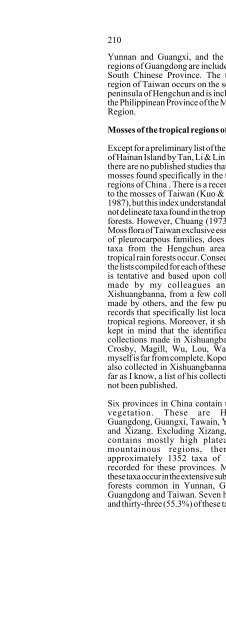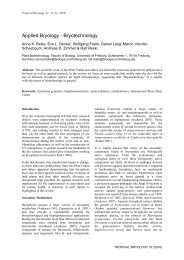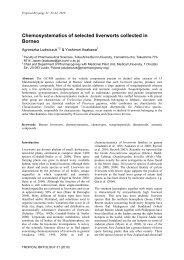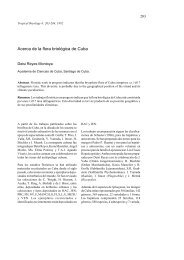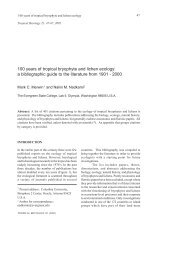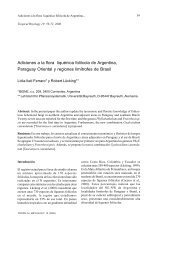Tropical component of the Moss Flora of China
Tropical component of the Moss Flora of China
Tropical component of the Moss Flora of China
Create successful ePaper yourself
Turn your PDF publications into a flip-book with our unique Google optimized e-Paper software.
210<br />
Yunnan and Guangxi, and <strong>the</strong> coastal<br />
regions <strong>of</strong> Guangdong are included in his<br />
South Chinese Province. The tropical<br />
region <strong>of</strong> Taiwan occurs on <strong>the</strong> sou<strong>the</strong>rn<br />
peninsula <strong>of</strong> Hengchun and is included in<br />
<strong>the</strong> Philippinean Province <strong>of</strong> <strong>the</strong> Malesian<br />
Region.<br />
<strong>Moss</strong>es <strong>of</strong> <strong>the</strong> tropical regions <strong>of</strong> <strong>China</strong><br />
Except for a preliminary list <strong>of</strong> <strong>the</strong> mosses<br />
<strong>of</strong> Hainan Island by Tan, Li & Lin (1987),<br />
<strong>the</strong>re are no published studies that list <strong>the</strong><br />
mosses found specifically in <strong>the</strong> tropical<br />
regions <strong>of</strong> <strong>China</strong> . There is a recent index<br />
to <strong>the</strong> mosses <strong>of</strong> Taiwan (Kuo & Chiang<br />
1987), but this index understandably does<br />
not delineate taxa found in <strong>the</strong> tropical rain<br />
forests. However, Chuang (1973) in his<br />
<strong>Moss</strong> flora <strong>of</strong> Taiwan exclusive essentially<br />
<strong>of</strong> pleurocarpous families, does cite 55<br />
taxa from <strong>the</strong> Hengchun area where<br />
tropical rain forests occur. Consequently,<br />
<strong>the</strong> lists compiled for each <strong>of</strong> <strong>the</strong>se regions<br />
is tentative and based upon collections<br />
made by my colleagues and I in<br />
Xishuangbanna, from a few collections<br />
made by o<strong>the</strong>rs, and <strong>the</strong> few published<br />
records that specifically list localities in<br />
tropical regions. Moreover, it should be<br />
kept in mind that <strong>the</strong> identification <strong>of</strong><br />
collections made in Xishuangbanna by<br />
Crosby, Magill, Wu, Lou, Wang and<br />
myself is far from complete. Koponen has<br />
also collected in Xishuangbanna but, as<br />
far as I know, a list <strong>of</strong> his collections has<br />
not been published.<br />
Six provinces in <strong>China</strong> contain tropical<br />
vegetation. These are Hainan,<br />
Guangdong, Guangxi, Tawain, Yunnan,<br />
and Xizang. Excluding Xizang, which<br />
contains mostly high plateau and<br />
mountainous regions, <strong>the</strong>re are<br />
approximately 1352 taxa <strong>of</strong> mosses<br />
recorded for <strong>the</strong>se provinces. Many <strong>of</strong><br />
<strong>the</strong>se taxa occur in <strong>the</strong> extensive subtropical<br />
forests common in Yunnan, Guangxi,<br />
Guangdong and Taiwan. Seven hundred<br />
and thirty-three (55.3%) <strong>of</strong> <strong>the</strong>se taxa area<br />
recorded for Yunnan Province. One<br />
hundred and sixty-six (12.5%) taxa are<br />
recorded for Guangdong Province. One<br />
hundred and nineteen (9.1%) are recorded<br />
from Hainan Province. Only 54 (4.1%)<br />
taxa are recorded from Guangxi Province.<br />
The largest number <strong>of</strong> taxa , 831 (66.1%),<br />
are recorded from Taiwan. A comparison<br />
<strong>of</strong> <strong>the</strong>se figures with <strong>the</strong> number <strong>of</strong> taxa<br />
specifically recorded from tropical regions<br />
indicates how little is known. Only 189<br />
taxa are known specifically from<br />
Xishuangbanna, 119 taxa from Hainan<br />
Island and 55 taxa (mostly acrocarpous)<br />
are known from Hengchun in Taiwan.<br />
For <strong>the</strong> Medog area <strong>of</strong> Xizang, 421 taxa<br />
are reported Wu & Lou (1981). A list <strong>of</strong><br />
<strong>the</strong>se taxa has not been published. The<br />
number <strong>of</strong> taxa for <strong>the</strong> Medog area may be<br />
low since at least one large collection <strong>of</strong><br />
mosses from this area by Y.-G. Su has yet<br />
to be cataloged and identified.<br />
Geographical Analysis <strong>of</strong> <strong>the</strong> mosses <strong>of</strong><br />
tropical regions <strong>of</strong> <strong>China</strong><br />
For <strong>the</strong> purpose <strong>of</strong> this analysis I have<br />
included only those taxa that have been<br />
specifically cited in <strong>the</strong> literature as<br />
occurring in regions where tropical<br />
vegetation occurs [Hainan (Tan & Li, &<br />
Lin 1987), Hengchun in Taiwan (Chuang<br />
(1973), Xishuangbanna (Redfearn et al<br />
1989), and Medog in Xizang (Wu & Lou,<br />
1981] or have been found in recent field<br />
studies by myself and o<strong>the</strong>rs in<br />
Xishuangbanna. This provides a total <strong>of</strong><br />
329 taxa (Table 1) upon which to base an<br />
analysis. In actual number this may be<br />
adequate but its sources, except for Hainan,<br />
come from a highly skewed taxonomic<br />
sample. The Taiwan sample is limited<br />
primarily to acrocarpous mosses and <strong>the</strong><br />
Xishuangbanna sample is based upon<br />
identifications in genera or families for<br />
which some reasonably good literature for<br />
<strong>the</strong> region is available such as <strong>the</strong><br />
Meteoriaceae, Pottiaceae, Calymperaceae,<br />
Mniaceae, Neckeraceae, Leskeaceae, Atrichum,<br />
Fissidens, Grimmia, Forsstroemia,


